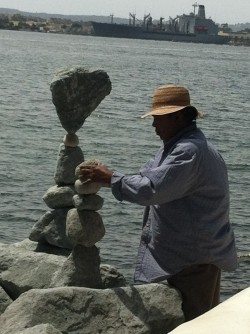 A week ago I was thrust into a new world and I went joyfully to explore. The results, I am afriad, were in some respects an all too familiar state of being. I am thankful for the insight it gave me; it renewed my awareness of how a new activity can both frustrate and bring insight on how we react to life. As a teacher it also helped me remember and be in touch with what students may feel upon presentation of new stimulus and ideas.
A week ago I was thrust into a new world and I went joyfully to explore. The results, I am afriad, were in some respects an all too familiar state of being. I am thankful for the insight it gave me; it renewed my awareness of how a new activity can both frustrate and bring insight on how we react to life. As a teacher it also helped me remember and be in touch with what students may feel upon presentation of new stimulus and ideas.
The opportunity to try something new came at my 10 year old Granddaughter’s birthday party. I tried archery for the first time decades ago. While a bit nervous, I will admit I was curious to discover how I would adapt and apply the principles of the Alexander Technique to this new activity. If I wanted to explore, I did not lack opportunity. There was. indeed, much to explore. Everything was new_ holding the bow, holding the arrow, aiming, pulling back the arrow, to name a few. My intellectual self remembered much, but my physical self literally could not find coordination.
We Alexander Technique teachers teach the principle of faulty sensory awareness. Alexander teaches us that we don’t necessarily know what we are doing, that we think we are perfoming one way, but are not actually doing as we think. Our habits become natural and normal to us. In turn, a better way of doing will seem wrong. At this point, Alecander says, “why would anyone change to that better way when it feels so wrong?” Our job as Alexander Technique teachers is to guide students into change by helping them experience the new and better way until it finally becomes the new habit, the new and improved normal.
Back to my archery experience and my own faluty sensory awareness. The teacher came over to help me as I pulled the arrow back. I understood to align my hand with my jaw. NO, I was NOT aware that I was pulling the arrow way back beyond my jaw. My coordination was totally off and after the first round my aiming was also a total enigma. I was newly and acutely reminded of that confusion, mental, physical, and emotional, that ascends when one tries something totally new. Also, my desire to “do-it-right” was very strong; with that desire came the enclosures and contracting of muscles, rather than expansion and opening. My breath? I didn’t notice. But, I am sure it was being held. LOTS!! Because I was trying to be so thoughtful, I also was slow. Yes, being slow bothered me as well, although I do believe being slow was problem. My reaction being slow was not helpful, however. Being last felt like a problem and the brain chatter said, “get going everyone is waiting!” After three rounds of arrows I gave up to allow another adult to give it a go. I was mentally worn out. I had learned enough about myself for one evening. I also realized again that I am very competitive and determined and that contributes to the ‘got-to-get-it-right” attitude. No doubt, beyond just being aware there was much to inhibit that night. In spite of my feelings of total confusion and ineptitude, amazingly, I really enjoyed learning. I felt frustrated in my confusion, but that frustration was overpowered by my curiosity at trying something new. I’d like to go back with an Alexander Technique teaching buddy and give it another go.
Exploring a new activity is a wonderful way to practice awareness of our selves, mentally, physically and emotionally. I think our habits must jump up and down with glee at the opportunity to reassert themselves. Maybe I will even go again to try the sport. It’s fun to take the time to explore the Alexander Technique at work in myself and perhaps find some balance, ease, and maybe even some poise in a new activity. It’s also a vivid reminder of the habits that are poised to challenge.